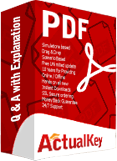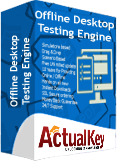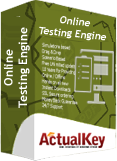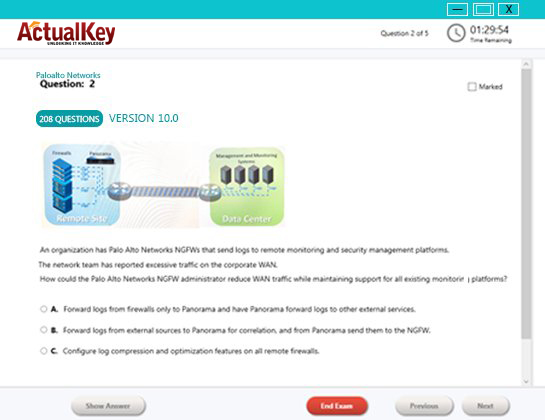Limited Time 30% Discount Offer Use Code - off30
Actualkey Prepration Latest MB6-886 : Microsoft Dynamics AX 2012 Process Manufacturing Production and Logistics Questions and Answers PDF's, Verified Answers via Experts - Pass Your Exam For Sure and instant Downloads - "Money Back Guarantee".
| Vendor | Microsoft |
| Certification | Microsoft Dynamics Certified Technology Specialist |
| Exam Code | MB6-886 |
| Title | Microsoft Dynamics AX 2012 Process Manufacturing Production and Logistics |
| No Of Questions | 149 |
| Last Updated | July 1,2024 |
| Product Type | Q & A with Explanation |
| Bundel Pack Included | PDF + Offline / Andriod Testing Engine and Simulator |
MB6-886
Microsoft Dynamics AX 2012 Process Manufacturing Production and Logistics
Language(s): English, French, German, Italian, Spanish
Audience(s): Information Workers
Technology: Microsoft Dynamics AX 2012
Type: Proctored Exam
Preparing for an Exam
This certification exam measures your ability to understand and articulate how to use Process Manufacturing business processes and functions in Microsoft Dynamics AX 2012 including preparing for process manufacturing; managing formulas and batch orders; managing master planning; managing containerized packaging and catch weight, and integrating with warehouse management; managing lot and batch control and batch attributes; managing vendor information; managing commodity pricing; managing product compliance; and managing rebates.
Exam Topics Covered
The following list includes the topic area covered on this exam.
Preparing for Process Manufacturing
Managing Formulas and Batch Orders
Managing Master Planning
Managing Containerized Packaging and Catch Weight, and Integrating with Warehouse Management
Managing Lot and Batch Control and Batch Attributes
Managing Vendor Information
Managing Commodity Pricing
Managing Product Compliance
Managing Rebates
Audience Profile
This exam is intended for individuals who plan to use Process Manufacturing business processes and functions in Microsoft Dynamics AX 2012. This audience typically includes systems developers and implementation consultants.
Additional Skills Recommended:
General working knowledge of process manufacturing and the Microsoft Dynamics AX 2012 functionalities that apply to process manufacturing.
Credit Toward Certification
When you pass Exam MB6-886: Microsoft Dynamics AX 2012 Process Manufacturing Production and Logistics, you complete the requirements for the following certification(s):
Microsoft Dynamics Certified Technology Specialist
This Training will Cover
This exam measures your ability to accomplish the technical tasks listed below. The percentages indicate the relative weight of each major topic area on the exam. The higher the percentage, the more questions you are likely to see on that content area on the exam.
The information after “This objective may include but is not limited to” is intended to further define or scope the objective by describing the types of skills and topics that may be tested for the objective. However, it is not an exhaustive list of skills and topics that could be included on the exam for a given skill area. You may be tested on other skills and topics related to the objective that are not explicitly listed here.
Preparing for Process Manufacturing (13 percent)
Understand process manufacturing concepts.
This topic may include: define process manufacturing prerequisites; differentiate between formula items and bill of materials (BOM) items; create a product at enterprise level; create and apply a product template
Set up fields related to process manufacturing.
This topic may include: set up fields related to catch weight, item model group, tracking dimension group, shelf life, production type, approved vendor, packaging for bulk and packed items, batch attributes, and compliance
Managing Formulas and Batch Orders (14 percent)
Understand formula concepts.
This topic may include: production types used in released products; difference between formula item and planning item; definition of lines and versions; access and use the Formula designer and Formula forms from different forms; use formulas and routes in multisite production environments
Manage formula versions.
This topic may include: control formula versions by date, quantity, or site; create a formula with versions; use a plan group to substitute items; use step consumption functionality
Set up and enhance formula calculations.
This topic may include: define variances impacting batch order costing; define prerequisites for a formula calculation; set up a costing version, calculation group, cost group, or costing sheet; create and activate item prices in the costing version; allocate costs to co-products; distribute the burden for by-products
Calculate and estimate prices.
This topic may include: define variances that impact batch order costing; calculate cost price and sales price for formula items; open and use the Formula calculation form from different forms; review formula calculation details; perform batch order costing of planned co-products and by-products; enter and allocate costs to unplanned co-products and by-products; assign standard costing to formula items and co-products; estimate price for formula items from a sales order
Process batch orders.
This topic may include: define the batch order life cycle; create a batch order; process a batch order in the Batch order form; process a batch order by using the Manufacturing Execution System (MES) functionality; define the purpose and benefits of MES; explain MES registration types; clock in and clock out; start a job in batch order; report feedback about jobs in batch order; bundle jobs
Managing Master Planning (12 percent)
Perform master planning.
This topic may include: set up master planning specific to process manufacturing; define prerequisites for multi-site master planning; set up multi-site master planning; set up master planning across sites within a legal entity
Perform intercompany planning.
This topic may include: define intercompany planning; set up an intercompany planning group; create an intercompany purchase order; create an intercompany sales order; configure intercompany direct deliveries
Plan co-products.
This topic may include: create and use a planning item; create and use a planning formula
Managing Containerized Packaging and Catch Weight, and Integrating with Warehouse Management (12 percent)
Set up containerized packaging.
This topic may include: identify purpose and benefits of containerized packaging; convert bulk items; create a formula for a packed item; identify a bulk item on a formula version
Manage consolidated orders.
This topic may include: identify advantages of consolidated orders; firm or consolidate a planned batch order; add a batch order to or remove a batch order from a consolidated batch order; process consolidated batch orders; review the consolidated on-hand inventory
Set up catch weight items.
This topic may include: define preconditions for catch weight items; set up a catch weight item; set up a partial visibility or full visibility catch weight item
Create catch weight transactions.
This topic may include: create a purchase agreement, sales agreement, purchase order, or sales order in a catch weight unit; enter a delivery schedule on the purchase order line or sales order line in a catch weight unit; create a supply forecast in a catch weight unit; view net requirements in a catch weight unit; view pegging requirements in planned orders in a catch weight unit; create shipment staging or output orders in a catch weight unit; view on-hand inventory for a catch weight item
Incorporate catch weight in advanced warehouse management functions.
This topic may include: configure catch weight products for use with advanced warehouse management functions; perform inbound and outbound processes using catch weight units
Manage reservations in advanced warehouse management functions.
This topic may include: set up for reservation in process manufacturing; reservation principles specific to process manufacturing; sort reservations in the shipment process; reserve inventory specific to process manufacturing; set up automatic batch reservation
Managing Lot and Batch Control and Batch Attributes (11 Percent)
Manage batch disposition codes.
This topic may include: define prerequisites for batch disposition codes; set up prerequisites for batch disposition codes; configure a batch disposition code; define batch disposition master fields; reset a batch disposition code
Configure shelf life for items.
This topic may include: set shelf advice, shelf life, and best before dates; process shelf life-related queries; update shelf advice, expiry date and best before dates; set up shelf life in master planning; configure customer sellable days; plan First Expiry-First Out (FEFO) date–controlled formula items
Create and maintain batch attributes.
This topic may include: create a batch attribute; add values to an enumerate type batch attribute; update a batch attribute; create a batch attribute group
Assign batch attributes.
This topic may include: assign product-specific or customer-specific batch attributes; reserve batches by attributes
Managing Vendor Information (10 percent)
Set up and maintain approved vendors for products.
This topic may include: set up an Approved Vendor List (AVL) in the item model group; set up an AVL check method; authorize approved vendors; add an approved vendor to an item; delete an approved vendor from an item; change the effective date or expiration date for an approved vendor
View and validate approved vendor information.
This topic may include: view approved vendors by item; view approved vendors in various modules and forms; view approved vendor expiration; inquire on an approved vendor’s items in various forms
Managing Commodity Pricing (10 percent)
Set up commodity pricing.
This topic may include: set up commodity pricing default parameters; set up commodity pricing in the inventory and warehouse management parameters
Set up a pricing calculation for a commodity item.
This topic may include: define the commodity pricing cycle; create price and margin data; create a pricing template; use a quantity and margin template; calculate the cost and sales price of an item
Managing Product Compliance (10 percent)
Set up and maintain product compliance.
This topic may include: define product compliance terms; set up for product compliance; set up restricted products; set up regulated products; set up a product safety data sheet (PSDS)
Implement product compliance.
This topic may include: associate product compliance to released products; validate PSDS information in purchase orders and sales orders
Managing Rebates (9 percent)
Set up rebates and rebate groups.
This topic may include: define the rebate process cycle; define prerequisites for rebates; set up rebates; set up rebate program types
Create rebate groups.
This topic may include: create customer rebate groups; create customer Trade and Merchandising Allowance (TMA) groups; create item freight groups; create item rebate groups
Create rebate agreements.
This topic may include: create a rebate agreement based on customer and item relationships; create a rebate agreement based on customer and item rebate groups
Set up rebate processing.
This topic may include: define the rebate process cycle; cumulate rebates; approve rebates; process rebates; purge rebates
I Got My Success Due To Actualkey MB6-886 Bundle Pack Actualkey experts I got passed in the MB6-886 exam without any worries at all, these exam material products gave me the reason to relax.
Budi Saptarmat
Yahoo! Got Successfully Through The MB6-886 Exam Passing Exam is not a easy thanks to Acutalkey.com for providing me actual MB6-886 Microsoft Dynamics AX 2012 Process Manufacturing Production and Logistics training with there included the Offline and Android simulators helps me success
Melinda
MB6-886 Exam Best Preparation I have been preparing for MB6-886 Microsoft Dynamics AX 2012 Process Manufacturing Production and Logistics, I was not sure that I'll be able to pass because of the fact that I am not a good student however;Actualkey.com provided me best and simple exam training pdf's and I passed. I now recommend everyone
Antonio Moreno
Actualkey.com MB6-886 Offline Simulator is Best My choice to select Actualkey.com and go for the preparation MB6-886 Microsoft Dynamics AX 2012 Process Manufacturing Production and Logistics, because I got the short way with the easy way
Liliane Meichner
Actualkey.com MB6-886 Exam PDF"s passed with in a week MB6-886 exam pdf's that's amazing
James Wilson
Microsoft - RELATED EXAMS
Designing a Database Server Infrastructure by Using Microsoft SQL Server 2005
Questions: 92 Questions | September 16, 2024
Optimizing and Maintaining a Database Administration Solution by Using SQL Server 2005
Questions: 215 | September 16, 2024
UPGRADE: MCDBA Skills to MCITP Database Administrator by Using Microsoft SQL Server 2005
Questions: 186 Questions | September 16, 2024
Microsoft .NET Framework 2.0 - Windows-Based Client Development
Questions: 245 Questions | September 16, 2024
Microsoft .NET Framework 2.0 - Distributed Application Development
Questions: 144 | September 16, 2024
Microsoft .NET Framework 2.0-Application Development Foundation
Questions: 456 | September 16, 2024
Designing and Developing Web-Based Applications by Using the Microsoft .NET Framework
Questions: 74 | September 16, 2024
Designing and Developing Windows-Based Applications by Using the Microsoft .NET Framework
Questions: 72 Questions | September 16, 2024
Designing and Developing Enterprise Applications by Using the Microsoft .NET Framework
Questions: 86 | September 16, 2024
UPGRADE: MCAD Skills to MCPD Web Developer by Using the Microsoft .NET Framework
Questions: 584 | September 16, 2024
UPGRADE: MCAD Skills to MCPD Windows Developer by Using the Microsoft .NET Framework
Questions: 559 | September 16, 2024
UPGRADE: MCSD Microsoft .NET Skills to MCPD Enterprise Application Developer: Part 1
Questions: 609 | September 16, 2024
UPGRADE: MCSD Microsoft .NET Skills to MCPD Enterprise Application Developer: Part 2
Questions: 168 | September 16, 2024
TS: Deploying and Maintaining Windows Vista Client and 2007 Microsoft Office System Desktops
Questions: 92 | September 16, 2024
Windows Server 2008 Applications Infrastructure, Configuring
Questions: 494 | September 16, 2024
TS: Upgrading from Windows Server 2003 MCSA to, Windows Server 2008, Technology Specializations
Questions: 576 | September 16, 2024
Designing a Microsoft Office Enterprise Project Management (EPM) Solution
Questions: 50 Questions | September 16, 2024
Customizing Portal Solutions with Microsoft SharePoint Products and Technologies
Questions: 75 | September 16, 2024
Deploying Business Desktops with Microsoft Windows Server 2003 and Microsoft Office 2003
Questions: 53 | September 16, 2024
Implementing and Administering Security in a Microsoft Windows Server 2003 Network
Questions: 288 | September 16, 2024
Designing, Deploying, and Managing a Network Solution for a Small- and Medium-Sized Business
Questions: 204 | September 16, 2024
Supporting Users and Troubleshooting a Microsoft Windows XP Operating System
Questions: 114 | September 16, 2024
TS: Microsoft SQL Server 2008, Business Intelligence Development and Maintenance
Questions: 399 | September 16, 2024
PRO: Designing, Optimizing and Maintaining a Database Administrative Solution Using Microsoft SQL Server 2008
Questions: 189 | September 16, 2024
Developing E-Business Solutions Using Microsoft BizTalk Server 2004
Questions: 40 | September 16, 2024
Developing Microsoft Office Solutions Using XML with Office Professional Edition 2003
Questions: 50 | September 16, 2024
Planning and Building a Messaging and Collaboration Environment Using Microsoft Office System and Microsoft Windows Server 2003
Questions: 61 | September 16, 2024
TS: Microsoft .NET Framework 3.5, ADO.NET Application Development
Questions: 287 | September 16, 2024
TS: Microsoft .NET Framework 3.5, ASP.NET Application Development
Questions: 364 | September 16, 2024
TS: Microsoft Office Project Server 2007, Managing Projects
Questions: 145 | September 16, 2024
TS: Microsoft .NET Framework 3.5, Windows Forms Application Development
Questions: 48 | September 16, 2024
Upgrade: Transition Your MCITP SQL Server 2005 DBA to MCITP SQL Server 2008
Questions: 98 | September 16, 2024
Pro: Designing and Deploying Messaging Solutions with Microsoft Exchange Server 2010
Questions: 379 | July 1, 2024
Pro: Designing and Developing ASP.NET Applications Using the Microsoft .NET Framework 3.5
Questions: 281 | September 16, 2024
TS: Microsoft SQL Server 2008, Implementation and Maintenance
Questions: 328 | September 16, 2024
Microsoft System Center Configuration Manager 2007,Configuring
Questions: 184 | September 16, 2024
PRO: Designing and Developing Microsoft SharePoint 2010 Applications
Questions: 200 | September 16, 2024
Upgrading to Windows 7 MCITP Enterprise Desktop Support Technician
Questions: 50 | September 16, 2024
TS: Windows Applications Development with Microsoft .NET Framework 4
Questions: 278 | September 16, 2024
TS: Windows Communication Foundation Development with Microsoft .NET Framework 4
Questions: 473 | September 16, 2024
TS: Web Applications Development with Microsoft .NET Framework 4
Questions: 405 | September 16, 2024
Pro: Designing and Developing Web Applications Using Microsoft .NET Framework 4
Questions: 288 | September 16, 2024
TS: Developing Business Process and Integration Solutions by Using Microsoft BizTalk Server 2010
Questions: 100 | September 16, 2024
Designing and Providing Microsoft Volume Licensing Solutions to Small and Medium Organizations
Questions: 232 | September 16, 2024
TS: Forefront Protection for Endpoints and Applications, Configuring
Questions: 105 | September 16, 2024
Upgrade: Transition Your MCITP SQL Server 2005 DBD to MCITP SQL Server 2008 DBD
Questions: 154 | July 1, 2024
Pro: Windows Server 2008 R2, Virtualization Administrator
Questions: 176 | September 16, 2024
PRO: Designing Database Solutions and Data Access Using Microsoft SQL Server 2008
Questions: 183 | July 1, 2024
Managing and Maintaining a Microsoft Windows Server 2003 Environment
Questions: 450 | July 1, 2024
Implementing Data Models and Reports with Microsoft SQL Server 2012
Questions: 330 | July 1, 2024
Implementing a Data Warehouse with Microsoft SQL Server 2012
Questions: 322 | September 16, 2024
Transition Your MCTS on SQL Server 2008 to MCSA: SQL Server 2012, Part 2
Questions: 300 | September 16, 2024
Configuring and Deploying a Private Cloud with System Center 2012
Questions: 462 | September 16, 2024
Monitoring and Operating a Private Cloud with System Center 2012
Questions: 457 | September 16, 2024
Administering and Deploying System Center 2012 Configuration Manager
Questions: 208 | September 16, 2024
Microsoft Dynamics AX 2012 Process Manufacturing Production and Logistics
Questions: 149 | July 1, 2024
Advanced Metro style App Development using HTML5 and JavaScript
Questions: 225 | September 16, 2024
Transition Your MCTS on SQL Server 2008 to MCSA: SQL Server 2012, Part 1
Questions: 230 | September 16, 2024
Transition Your MCITP: Database Administrator 2008 or MCITP: Database Developer 2008 to MCSE: Data Platform
Questions: 261 | September 16, 2024
Transition Your MCITP: Business Intelligence Developer 2008 to MCSE: Business Intelligence
Questions: 132 | September 16, 2024
Designing Database Solutions for Microsoft SQL Server 2012
Questions: 231 | September 16, 2024
Designing Business Intelligence Solutions with Microsoft SQL Server 2012 Exam
Questions: 314 | September 16, 2024
Microsoft Programming in HTML5 with JavaScript and CSS3 Exam
Questions: 342 | September 16, 2024
Delivering Continuous Value with Visual Studio 2012 Application Lifecycle Management
Questions: 219 | July 1, 2024
Enterprise Voice & Online Services with Microsoft Lync Server 2013
Questions: 158 | September 16, 2024
Developing Microsoft SharePoint Server 2013 Core Solutions
Questions: 181 | September 16, 2024
Upgrade your MCPD: Web Developer 4 to MCSD: Web Applications
Questions: 229 | September 16, 2024
Essentials of Developing Windows Metro style Apps using C#
Questions: 168 | September 16, 2024
Server Virtualization with Windows Server Hyper-V and System Center
Questions: 149 | September 16, 2024
Essentials of Developing Windows Metro style Apps using HTML5 and JavaScript
Questions: 166 | September 16, 2024
TS: Windows Small Business Server 2011 Standard, Configuring
Questions: 55 | September 16, 2024
TS: MS Internet Security & Acceleration Server 2006, Configuring
Questions: 80 | September 16, 2024
TS: Microsoft System Center Operations Manager 2007, Configuring
Questions: 94 | September 16, 2024
TS: System Center Virtual Machine Manager 2008, Configuring
Questions: 45 | September 16, 2024
PRO: Designing a Business Intelligence Infrastructure Using Microsoft SQL Server 2008
Questions: 115 | September 16, 2024
Upgrade: Transition Your MCITP SQL Server 2005 BI Developer to MCITP SQL Server 2008 BI Developer
Questions: 203 | September 16, 2024
Recertification for MCSD: Application Lifecycle Management
Questions: 292 | September 16, 2024
TS: Microsoft .NET Framework 3.5 Windows Presentation Foundation Application Development
Questions: 101 | September 16, 2024
TS: Microsoft .NET Framework 3.5 - Windows Communication Foundation
Questions: 270 | September 16, 2024
TS: Visual Studio Team Foundation Server 2010, Administration
Questions: 72 | September 16, 2024
Pro: Designing and Developing Windows Applications Using Microsoft .NET Framework 4
Questions: 239 | September 16, 2024
TS: Microsoft Windows SharePoint Services 3.0 Application Development
Questions: 109 | September 16, 2024
Upgrade: Transition your MCPD Enterprise Application Developer Skills to MCPD Enterprise Application Developer 3.5, Part 1
Questions: 153 | September 16, 2024
UPGRADE: Transition your MCPD Enterprise Application Developer Skills to MCPD Enterprise Application Developer 3.5, Part 2
Questions: 123 | September 16, 2024
TS: System Center Data Protection Manager 2007, Configuring
Questions: 74 | September 16, 2024
Designing and Providing Microsoft Volume Licensing Solutions to Large Organizations
Questions: 126 | September 16, 2024
TS: Designing, Assessing, and Optimizing Software Asset Management (SAM)
Questions: 85 | September 16, 2024
MS Office Communication Server 2007-U.C Voice Specialization
Questions: 174 | September 16, 2024
Microsoft Office Communications Server 2007 R2 U.C. Voice Specialization
Questions: 101 | September 16, 2024
Windows Server 2008 Hosted Environments, Configuring and Managing
Questions: 75 | September 16, 2024
Designing and Providing Microsoft Volume Licensing Solutions to Large Organisations
Questions: 104 | September 16, 2024
Pro: Designing and Developing Windows Applications Using the Microsoft .NET Framework 3.5
Questions: 105 | July 1, 2024
Pro: Designing and Developing Enterprise Applications Using the Microsoft .NET Framework 3.5
Questions: 152 | September 16, 2024
Universal Windows Platform – App Data, Services, and Coding Patterns (beta)
Questions: 47 | September 16, 2024
Universal Windows Platform – App Architecture and UX/UI (beta)
Questions: 76 | September 16, 2024
Microsoft Dynamics AX 2012 R3 CU8 Installation and Configuration
Questions: 48 | July 1, 2024
Designing and Deploying Microsoft Exchange Server 2016 Exam
Questions: 166 | September 16, 2024
Introduction to Programming Using Block-Based Languages (Touch Develop)
Questions: 72 | July 1, 2024
Development, Extensions and Deployment for Microsoft Dynamics 365 for Finance and Operations
Questions: 90 | July 1, 2024
Financial Management in Microsoft Dynamics 365 for Finance and Operations
Questions: 73 | July 1, 2024
Designing and Providing Microsoft Licensing Solutions to Large Organizations
Questions: 195 | July 1, 2024
Distribution and Trade in Microsoft Dynamics 365 for Finance and Operations
Questions: 93 | July 1, 2024
Administering Microsoft System Center Configuration Manager and Cloud Services Integration
Questions: 150 | July 1, 2024
Microsoft Configuring and Operating a Hybrid Cloud with Microsoft Azure Stack Exam
Questions: 99 | July 1, 2024
Microsoft Azure Solutions Architect Certification Transition Exam
Questions: 393 | July 1, 2024
Outlook 2016: Core Communication, Collaboration and Email Skills
Questions: 35 | July 1, 2024
Microsoft Developing Solutions for Microsoft Azure Exam
Questions: 170 / 6 Case Study | July 1, 2024
Designing and Implementing a Data Science Solution on Azure Exam
Questions: 506 | July 28, 2025
Microsoft 365 Teamwork Administrator Certification Transition Exam
Questions: 120 | July 1, 2024
Microsoft Messaging Administrator Certification Transition Exam
Questions: 155 | July 1, 2024
Microsoft Excel 2016: Core Data Analysis, Manipulation, and Presentation Exam
Questions: 35 | November 8, 2024
Microsoft Word 2016: Core Document Creation, Collaboration and Communication Exam
Questions: 35 | November 8, 2024
Microsoft Dynamics 365 for Finance and Operations, Supply Chain Management Exam
Questions: 394 | November 25, 2024
Microsoft Dynamics 365 for Finance and Operations, Manufacturing Exam
Questions: 207 | November 8, 2024
Building Applications and Solutions with Microsoft 365 Core Services Exam
Questions: 242 | July 1, 2024
Microsoft Dynamics 365: Finance and Operations Apps Solution Architect Exam
Questions: 316 | September 18, 2025
Planning and Administering Microsoft Azure for SAP Workloads Exam
Questions: 289 | August 22, 2025
Microsoft Dynamics 365: Finance and Operations Apps Developer Exam
Questions: 304 | September 22, 2025
Administering Relational Databases on Microsoft Azure (beta) Exam
Questions: 341 | December 13, 2024
Microsoft Dynamics 365 Business Central Functional Consultant (beta) Exam
Questions: 213 | September 18, 2025
Microsoft Power Platform Functional Consultant (beta) Exam
Questions: 293 | September 26, 2025
Configuring and Operating a Hybrid Cloud with Microsoft Azure Stack Hub Exam
Questions: 176 | July 1, 2024
Microsoft Dynamics 365 Fundamentals Customer Engagement Apps (CRM) (beta) Exam
Questions: 159 | October 12, 2024
Microsoft Dynamics 365 Fundamentals Finance and Operations Apps (ERP) Exam
Questions: 151 | May 27, 2025
Configuring and Operating Windows Virtual Desktop on Microsoft Azure Exam
Questions: 261 | July 30, 2025
Designing and Implementing a Microsoft Azure AI Solution (beta) Exam
Questions: 379 | August 7, 2025
Designing and Implementing Microsoft Azure Networking Solutions Exam
Questions: 294 | March 1, 2025
Designing Microsoft Azure Infrastructure Solutions (beta) Exam
Questions: 340 | October 10, 2025
Designing and Implementing Cloud-Native Applications Using Microsoft Azure Cosmos DB (beta) Exam
Questions: 144 | May 24, 2025
Configuring Windows Server Hybrid Advanced Services (beta) Exam
Questions: 255 | November 5, 2025
Administering Windows Server Hybrid Core Infrastructure (beta) Exam
Questions: 256 | September 30, 2025
Microsoft Designing and Implementing Enterprise-Scale Analytics Solutions Using Microsoft Azure and Microsoft Power BI Exam
Questions: 160 | July 1, 2024
Microsoft Dynamics 365 Supply Chain Management Functional Consultant Expert Exam
Questions: 195 | July 12, 2025
Implementing Analytics Solutions Using Microsoft Fabric Exam
Questions: 140 | August 16, 2025
Implementing Data Engineering Solutions Using Microsoft Fabric Exam
Questions: 104 | June 6, 2025
Exams code, certifications, vendor or keywords
![]()
Copyright © 2009 - 2025 Actualkey. All rights reserved.





